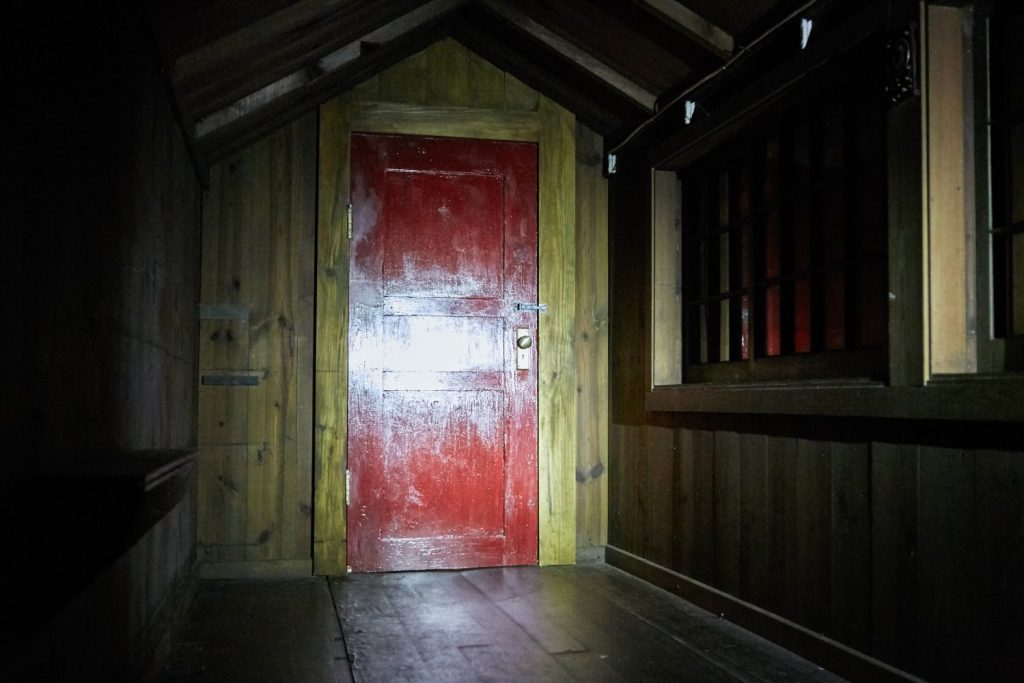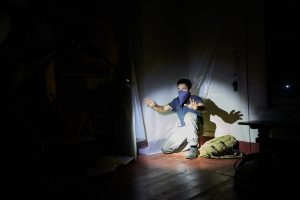 Title: It Comes at Night | Rated: R | Runtime: 97 min | Theaters nationwide
Title: It Comes at Night | Rated: R | Runtime: 97 min | Theaters nationwide
It Comes at Night will either exceed your expectations or prove to be a harsh reminder about the risks that stem from misleading marketing. Take a gander at its trailers – if you get the impression that this is a supernatural, creature, or slasher horror flick, you’d be forgiven. Heck, the title itself seems to imply that. If that’s what you think, then for your sake, do not prepare yourself for such a film. Trey Edward Shults’ sophomoric feature isn’t so much a horror film as it is an extremely bleak and thoughtful rumination on distrust, family, and paranoia. It’s certainly unsettling and well-intentioned, but it’s also frustratingly ambiguous.
 This is one helluva pressure cooker of a family drama, though the film’s deliberate ambiguity does get overwhelming. It follows two families as they live and work together to survive in a post-apocalyptic world as well as the conflict that ensues from this uneasy alliance. The film is at its best when it contrasts the dynamic and personalities of these two families, all of which is processed through the eyes, ears, and mind of seventeen-year-old Travis (Kelvin Harrison, Jr.). It is ultimately about the lengths one will go to protect his or her family, and as we see this motif play out in the characters’ choices, the results are just gut-wrenching, heartbreaking, and nihilistic. However, Shults insistently wraps the whole film in ambiguity (aided in large part by Travis’ multiple dream sequences, where most of the scares come from) as it goes along that it can’t help but drown in it. Now, ambiguity certainly isn’t a bad thing (see Exhibit A for Oldboy, No Country for Old Men, and The Wailing), and while movies shouldn’t necessarily provide answers to every question they raise, it shouldn’t get in the way of closure, nor should questions stemming from key plot points overwhelm the effect that the film tries to achieve – which is why It Comes at Night falls short of greatness for me personally. I’ve seen the film twice now, and while I appreciated it more the second time around (I admit to being quite frustrated the first time), those questions still pervaded heavily, and I still felt the payoff was underwhelming given how much emotional investment I put into the film. I completely understand what Shults is going for here, but his reach decidedly exceeds his grasp.
This is one helluva pressure cooker of a family drama, though the film’s deliberate ambiguity does get overwhelming. It follows two families as they live and work together to survive in a post-apocalyptic world as well as the conflict that ensues from this uneasy alliance. The film is at its best when it contrasts the dynamic and personalities of these two families, all of which is processed through the eyes, ears, and mind of seventeen-year-old Travis (Kelvin Harrison, Jr.). It is ultimately about the lengths one will go to protect his or her family, and as we see this motif play out in the characters’ choices, the results are just gut-wrenching, heartbreaking, and nihilistic. However, Shults insistently wraps the whole film in ambiguity (aided in large part by Travis’ multiple dream sequences, where most of the scares come from) as it goes along that it can’t help but drown in it. Now, ambiguity certainly isn’t a bad thing (see Exhibit A for Oldboy, No Country for Old Men, and The Wailing), and while movies shouldn’t necessarily provide answers to every question they raise, it shouldn’t get in the way of closure, nor should questions stemming from key plot points overwhelm the effect that the film tries to achieve – which is why It Comes at Night falls short of greatness for me personally. I’ve seen the film twice now, and while I appreciated it more the second time around (I admit to being quite frustrated the first time), those questions still pervaded heavily, and I still felt the payoff was underwhelming given how much emotional investment I put into the film. I completely understand what Shults is going for here, but his reach decidedly exceeds his grasp.
 One cannot emphasize enough how marvelous the cast is. While it certainly helps that the film features strong character work, the actors play a significant role in bringing their characters to life. Joel Edgerton and Christopher Abbott shine here as the resolute, shifty-eyed patriarchs of their families, and the dialogue-driven scenes they share highlight the simmering restraint they put into their performances. Also excellent are Carmen Ejogo and Riley Keough as the matriarchs, who exude tenderness and warmth until the time comes for them to go on either the offensive or the defensive, where their desire to protect their families manifests in dogged determination. While his character doesn’t have much to do, Griffin Robert Faulkner, who plays the film’s only child, definitely does his part to bring out the best in his co-stars. If anything, though, the film belongs to Harrison, as Travis is our window into this distressing world. We share every one of his emotions whenever he’s in frame, whether it’s confusion, fear, loneliness, or lust, and the actor communicates so much with his eyes and expressions.
One cannot emphasize enough how marvelous the cast is. While it certainly helps that the film features strong character work, the actors play a significant role in bringing their characters to life. Joel Edgerton and Christopher Abbott shine here as the resolute, shifty-eyed patriarchs of their families, and the dialogue-driven scenes they share highlight the simmering restraint they put into their performances. Also excellent are Carmen Ejogo and Riley Keough as the matriarchs, who exude tenderness and warmth until the time comes for them to go on either the offensive or the defensive, where their desire to protect their families manifests in dogged determination. While his character doesn’t have much to do, Griffin Robert Faulkner, who plays the film’s only child, definitely does his part to bring out the best in his co-stars. If anything, though, the film belongs to Harrison, as Travis is our window into this distressing world. We share every one of his emotions whenever he’s in frame, whether it’s confusion, fear, loneliness, or lust, and the actor communicates so much with his eyes and expressions.
 Though his insistence on making the film open to interpretation backfires, Shults sure as hell as knows how to craft a disconcerting atmosphere befitting of any fine horror film. He works with a limited setting here (a house and the woods), but it augments both the characters’ anxiety and ours to almost unbearable levels. Cinematographer Drew Daniels uses natural light or single light sources to ensure that darkness has a keenly felt presence in each frame, and the way that he and Shults subtly fiddle with the aspect ratio during the dream sequences (look for letterboxes) keeps us on edge. Combine that with Karen Murphy’s production design for the boarded-up house, and we have ourselves an environment where an eerie sense of claustrophobia can never be shaken off, even during moments of family-bonding respite. Brian McOmber’s sparse and unsettling score, along with an incredibly crisp sound design, make us feel uncomfortable and anticipate dread at any given moment.
Though his insistence on making the film open to interpretation backfires, Shults sure as hell as knows how to craft a disconcerting atmosphere befitting of any fine horror film. He works with a limited setting here (a house and the woods), but it augments both the characters’ anxiety and ours to almost unbearable levels. Cinematographer Drew Daniels uses natural light or single light sources to ensure that darkness has a keenly felt presence in each frame, and the way that he and Shults subtly fiddle with the aspect ratio during the dream sequences (look for letterboxes) keeps us on edge. Combine that with Karen Murphy’s production design for the boarded-up house, and we have ourselves an environment where an eerie sense of claustrophobia can never be shaken off, even during moments of family-bonding respite. Brian McOmber’s sparse and unsettling score, along with an incredibly crisp sound design, make us feel uncomfortable and anticipate dread at any given moment.
There’s so much to like about It Comes at Night that it’s disappointing to me how much its ambiguity overshadows. This is no doubt a very polarizing movie, and I do wish I walked out of it singing nothing but praises instead of walking out it befuddled and frustrated.
Rating: 3.5/5.0
* Photos courtesy of A24
